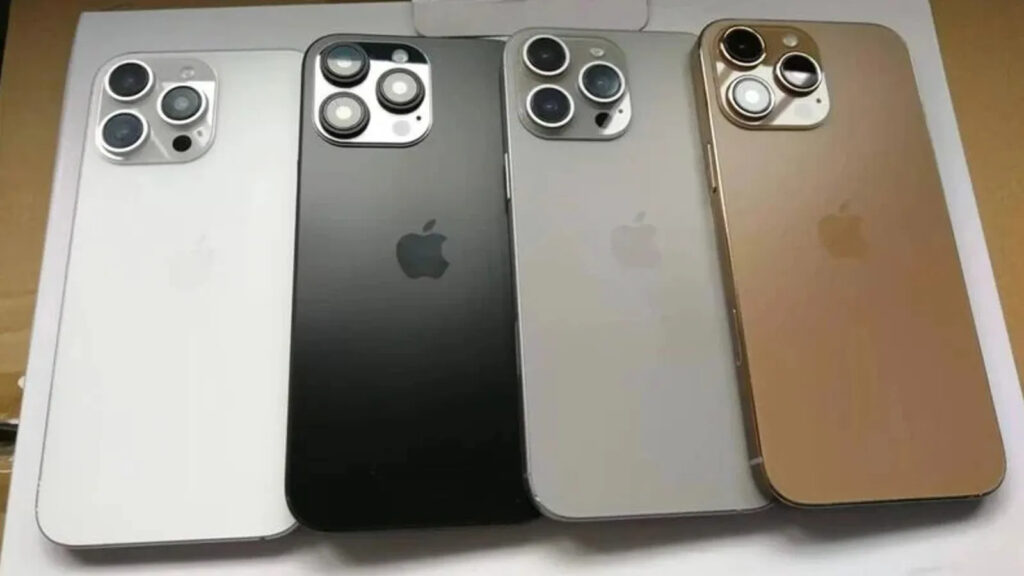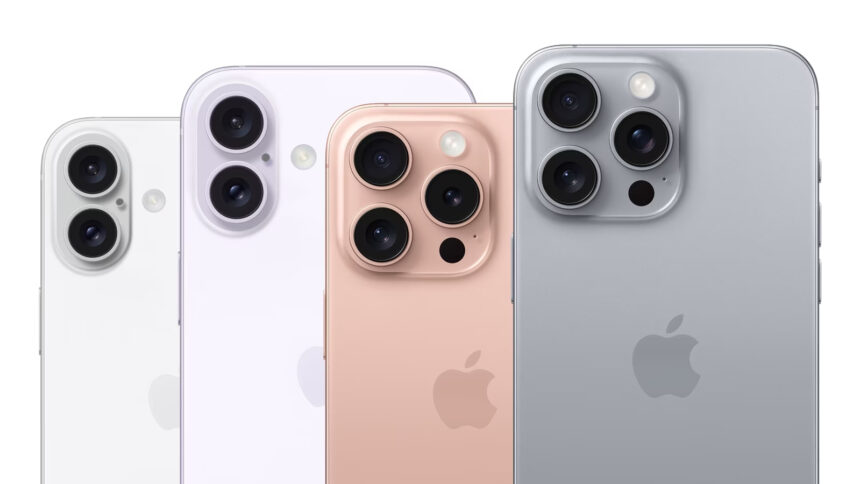The iPhone 16 series represents Apple’s latest advancement in smartphone technology, bringing four models that cater to different user preferences: the iPhone 16, iPhone 16 Plus, iPhone 16 Pro, and iPhone 16 Pro Max. Each model comes with its own set of features, specifications, and price points, designed to appeal to a wide range of customers, from casual users to power-hungry professionals. This detailed guide will walk you through the primary differences between these models and the pricing structures, including how new launches affect price variations across the iPhone lineup.
Overview of the iPhone 16 Series
| Feature | iPhone 16 | iPhone 16 Plus | iPhone 16 Pro | iPhone 16 Pro Max |
|---|---|---|---|---|
| Display Size | 6.1-inch OLED | 6.7-inch OLED | 6.3-inch OLED (ProMotion 120Hz) | 6.9-inch OLED (ProMotion 120Hz) |
| Resolution | 2556 x 1179 | 2796 x 1290 | 2670 x 1230 | 3000 x 1400 |
| Chipset | A17 Bionic | A17 Bionic | A18 Pro | A18 Pro |
| Rear Cameras | Dual 12MP (Main, Ultra-Wide) | Dual 12MP (Main, Ultra-Wide) | Triple 48MP (Main, Ultra-Wide, Telephoto) | Triple 48MP (Main, Ultra-Wide, Telephoto) |
| Front Camera | 12MP TrueDepth | 12MP TrueDepth | 12MP TrueDepth | 12MP TrueDepth |
| Video Recording | 4K, HDR, Cinematic Mode | 4K, HDR, Cinematic Mode | 4K ProRes, Dolby Vision, 120 fps | 4K ProRes, Dolby Vision, 120 fps |
| Battery Life | Up to 28 hours | Up to 32 hours | Up to 30 hours | Up to 33 hours |
| Charging | USB-C, MagSafe | USB-C, MagSafe | USB-C, MagSafe | USB-C, MagSafe |
| Materials | Recycled aluminum | Recycled aluminum | Recycled titanium and aluminum | Recycled titanium and aluminum |
| Water/Dust Resistance | IP68 | IP68 | IP68 | IP68 |
| Weight | 172 grams | 203 grams | 195 grams | 220 grams |
| 5G Support | Yes | Yes | Yes | Yes |
| Dynamic Island | Yes | Yes | Yes | Yes |
| Special Features | Always-On Display | Always-On Display | ProMotion, Camera Control Button | ProMotion, Camera Control Button |
| Price | Starting at $799 | Starting at $899 | Starting at $999 | Starting at $1,199 |
Key Differences:
- Display Size: The iPhone 16 and 16 Pro are more compact with a 6.1 and 6.3-inch display, respectively, while the iPhone 16 Plus and 16 Pro Max offer larger 6.7 and 6.9-inch screens.
- Performance: The Pro models are equipped with the A18 Pro chip for higher performance, while the iPhone 16 and 16 Plus use the A17 Bionic.
- Camera System: The Pro models feature a more advanced triple-camera system (48MP main sensor) along with features like ProRAW and LiDAR, while the iPhone 16 and Plus models have a dual-camera setup.
- Battery Life: The iPhone 16 Pro Max offers the best battery life (up to 33 hours), followed by the Plus (32 hours), Pro (30 hours), and standard iPhone 16 (28 hours).
- Price: The Pro models are more expensive, with the iPhone 16 starting at $799 and the iPhone 16 Pro Max starting at $1,199
Since its inception, the iPhone has always been at the cutting edge of smartphone innovation. With each new generation, Apple introduces new technology, design improvements, and performance upgrades that push the boundaries of what a smartphone can do. The iPhone 16 series is no different. Whether you’re looking for an everyday device or a high-performance machine, there’s an iPhone 16 model tailored to your needs.
Here’s a breakdown of the four models in the iPhone 16 series:
- iPhone 16: The standard version with a solid balance of performance and affordability.
- iPhone 16 Plus: A larger version of the iPhone 16 with an extended battery life and larger screen.
- iPhone 16 Pro: A premium model offering superior performance, an advanced camera system, and exclusive features like ProMotion and improved build quality.
- iPhone 16 Pro Max: The top-tier model with the largest display, the best camera features, and maximum performance capabilities.
Let’s delve into the details of each model, highlighting their differences in terms of display, build quality, camera systems, performance, and, most importantly, price.
Display: Comparing Size, Technology, and Refresh Rates

.
One of the most noticeable differences across the iPhone 16 models is the display. Apple has refined its display technology to deliver sharper visuals, smoother interactions, and better energy efficiency, but there are key differences between the models.
- iPhone 16: The iPhone 16 features a 6.1-inch Super Retina XDR display with a 60Hz refresh rate. While the screen is bright and delivers exceptional clarity with HDR10 and Dolby Vision support, the 60Hz refresh rate is a notable limitation, especially for users who crave smoother scrolling and animations.
- iPhone 16 Plus: The iPhone 16 Plus shares the same display technology but in a larger 6.7-inch form factor. The larger screen makes the Plus model more suitable for users who enjoy media consumption like streaming videos, gaming, or multitasking on a larger canvas.
- iPhone 16 Pro: The 16 Pro packs a 6.1-inch LTPO OLED display, similar in size to the standard iPhone 16 but with a significant upgrade in terms of refresh rate. The Pro models boast ProMotion technology with a 120Hz adaptive refresh rate, which dynamically adjusts between 10Hz and 120Hz depending on the content. This ensures fluid scrolling, smooth animations, and a more responsive touch experience. Additionally, the Pro models include Always-On Display (AOD) technology, allowing users to glance at their phones without fully unlocking the device.
- iPhone 16 Pro Max: The Pro Max features the same LTPO OLED panel but in a 6.7-inch size, making it the largest display in the iPhone 16 lineup. The larger display is ideal for users who want an immersive experience for entertainment or productivity tasks like editing videos or photos. The 120Hz refresh rate ensures a buttery-smooth experience, which is particularly useful for gamers and those who value the highest level of display fluidity.
Display Key Differences:
- The iPhone 16 and iPhone 16 Plus have Super Retina XDR displays with a 60Hz refresh rate.
- The iPhone 16 Pro and iPhone 16 Pro Max use LTPO OLED panels with ProMotion, supporting a 120Hz adaptive refresh rate.
- Size varies between the models, with the Plus and Pro Max models offering 6.7-inch displays, and the base iPhone 16 and iPhone 16 Pro offering 6.1-inch screens.
Build Quality and Design: Premium Materials and Color Options

Apple’s commitment to premium build quality is evident across all iPhone 16 models, though there are distinct differences between the standard and Pro models in terms of materials and finishes.
- iPhone 16 & iPhone 16 Plus: These models feature an aerospace-grade aluminum frame with a Ceramic Shield front cover, designed to offer excellent durability while maintaining a lightweight feel. The aluminum frame ensures that the iPhone 16 and iPhone 16 Plus are relatively light and easy to handle, even with their larger screens. They come in a variety of fun and vibrant colors like blue, red, and starlight, appealing to users who prefer a playful aesthetic.
- iPhone 16 Pro & iPhone 16 Pro Max: The Pro models are built using a more durable and premium surgical-grade stainless steel frame, which adds a noticeable heft and a more luxurious feel compared to the aluminum models. The rear glass panel has a matte finish, reducing fingerprints and smudges, and giving the phone a sleek, professional look. The Pro models come in exclusive color options like graphite, gold, and deep blue, reflecting their premium status.
Design Key Differences:
- The Pro models use surgical-grade stainless steel, offering more durability and a premium feel compared to the aluminum frames on the iPhone 16 and 16 Plus.
- Color options vary, with the standard models offering brighter, more playful hues, while the Pro models stick to more subdued and professional finishes.
Camera System: Advanced Photography for Pro Models
One of the biggest differentiators across the iPhone 16 lineup is the camera system. Apple has made significant improvements to the iPhone’s camera technology over the years, and the iPhone 16 series continues this trend. However, the Pro models offer significant advantages in terms of photography and videography features.
- iPhone 16 & iPhone 16 Plus: Both models come with a dual-camera system, consisting of a 12MP wide-angle lens and a 12MP ultra-wide lens. The iPhone 16 and 16 Plus retain excellent computational photography features, including Night Mode, Deep Fusion, and Smart HDR 4. However, they lack the telephoto and LiDAR features found in the Pro models, making them less versatile for professional photographers. The video recording capabilities are solid, with support for 4K recording at 60fps and Dolby Vision HDR.
- iPhone 16 Pro: The iPhone 16 Pro steps up with a triple-camera system, featuring a 12MP wide lens, a 12MP ultra-wide lens, and a 12MP telephoto lens with 3x optical zoom. The Pro models also feature Apple’s ProRAW and ProRes video recording capabilities, providing greater control over image quality and editing flexibility. Additionally, the Pro models include a LiDAR scanner, which enhances low-light photography and improves AR experiences.
- iPhone 16 Pro Max: The Pro Max takes things even further with the inclusion of a periscope zoom lens, allowing for up to 6x optical zoom. This makes the Pro Max ideal for users who require superior zoom capabilities, such as wildlife photographers or sports enthusiasts. The periscope lens also benefits from advanced optical image stabilization, ensuring crisp and clear photos even at long distances.
Camera Key Differences:
- The iPhone 16 and 16 Plus have dual-camera systems, while the Pro models feature triple-camera systems with telephoto lenses.
- The iPhone 16 Pro Max includes a periscope zoom lens for enhanced optical zoom (up to 6x).
- LiDAR and ProRAW/ProRes videos are exclusive to the Pro models.
Performance and Chipset: A17 Bionic vs. A17 Pro

Performance has always been one of the iPhone’s strong suits, and the iPhone 16 series is no exception. However, Apple has introduced a new level of performance with the A17 Pro chip, exclusive to the Pro models.
- iPhone 16 & iPhone 16 Plus: Both models are powered by the A17 Bionic chip, which is built on a 4nm process. The A17 Bionic features a 6-core CPU, a 5-core GPU, and a 16-core Neural Engine. The A17 Bionic offers faster performance compared to the A16, especially in AI and machine learning tasks, but it remains a step below the A17 Profound in the higher-end models.
- iPhone 16 Pro & iPhone 16 Pro Max: The Pro models introduce the A17 Pro chip, built on a 3nm architecture. This chip brings significant improvements in power efficiency and performance, especially for demanding tasks like gaming, video editing, and augmented reality applications. The A17 Pro features an 8-core CPU, a 6-core GPU, and a 20-core Neural Engine, making it one of the most powerful mobile processors on the market. The improved GPU performance is particularly beneficial for graphics-intensive tasks like gaming and rendering.
Performance Key Differences:
- The iPhone 16 and 16 Plus use the A17 Bionic chip, while the Pro models use the more advanced A17 Pro chip.
- The A17 Pro offers better performance in terms of CPU, GPU, and machine learning tasks, particularly for professional users and gamers.
Battery Life: Extended Usage for Larger Models
Battery life is an essential factor for any smartphone user, and Apple continues to improve efficiency across its devices. Battery performance is closely linked to the size of the device, with the larger models offering longer battery life.
- iPhone 16: The iPhone 16 has an estimated battery life of up to 18 hours of video playback, which is sufficient for most users but falls short of the larger models.
- iPhone 16 Plus: With its larger size, the iPhone 16 Plus offers extended battery life, capable of up to 24 hours of video playback.
- iPhone 16 Pro: The 16 Pro offers similar battery life to the standard iPhone 16, with up to 19 hours of video playback, thanks to the efficiency improvements of the A17 Pro chip.
- iPhone 16 Pro Max: The Pro Max is the battery king of the lineup, offering up to 26 hours of video playback. This makes it ideal for users who need their phone to last all day with intensive use.
Battery Key Differences:
- The larger Plus and Pro Max models offer significantly longer battery life compared to the standard iPhone 16 and 16 Pro.
Price Differences: New Launches and Price Variations
Apple’s pricing strategy for the iPhone 16 series reflects the varying levels of features and performance between the models. Pricing also fluctuates based on the storage options chosen, with each model available in multiple storage configurations.
- iPhone 16: Starting at $799, the iPhone 16 is the most affordable option in the lineup. Prices can increase based on the storage option, with 128GB, 256GB, and 512GB variants available.
- iPhone 16 Plus: Starting at $899, the iPhone 16 Plus offers a larger display and extended battery life at a relatively small premium over the base iPhone 16.
- iPhone 16 Pro: Starting at $1,099, the iPhone 16 Pro commands a higher price due to its ProMotion display, triple-camera system, and A17 Pro chip. Prices increase with additional storage, with 128GB, 256GB, 512GB, and 1TB options.
- iPhone 16 Pro Max: Starting at $1,199, the iPhone 16 Pro Max is the most expensive option, reflecting its larger display, superior camera system, and maximum performance capabilities.
Price Key Differences:
- The base iPhone 16 starts at $799, while the iPhone 16 Pro Max starts at $1,199.
- Price variations are driven by differences in display size, performance, camera capabilities, and storage options.
Conclusion: Which iPhone 16 Model is Right for You?
Choosing the right iPhone 16 model depends on your specific needs and budget. If you’re looking for an affordable yet capable iPhone, the standard iPhone 16 offers great performance and a solid camera system. For users who want a larger display and longer battery life without breaking the bank, the iPhone 16 Plus is an excellent choice.
For power users, professionals, or photography enthusiasts, the iPhone 16 Pro and iPhone 16 Pro Max offer the best features and performance, with advanced camera systems, 120Hz displays, and the A17 Pro chip. The Pro Max, in particular, is ideal for users who want the largest screen and the best battery life in the series.
No matter which model you choose, the iPhone 16 series delivers cutting-edge technology and Apple’s renowned user experience, ensuring that you’re getting one of the best smartphones available on the market.





